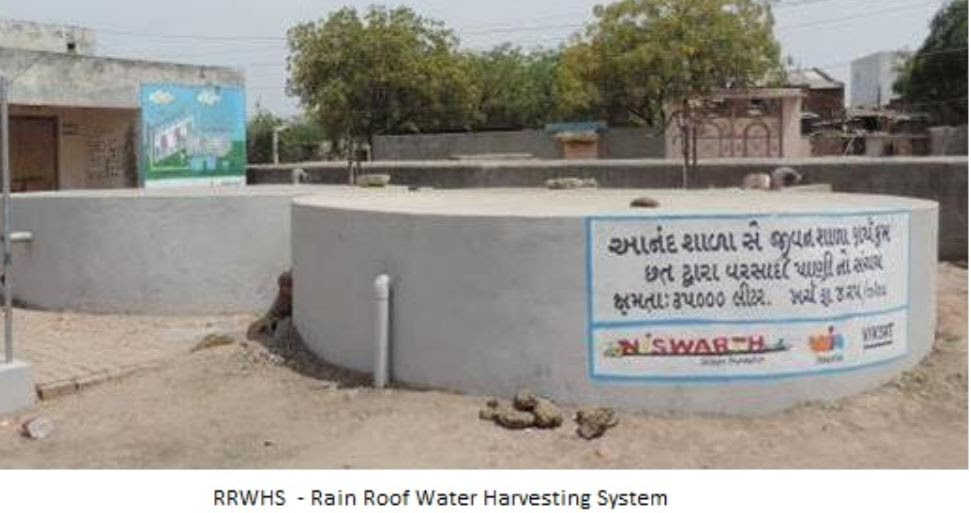Authors : Dr. Soumi Roy Chowdhury, Prof. Deepak Singhania, Ms. Shradhda Jain
The growing population and the global shifts in economic activities have led to nearly six-fold increase in the water demand since 1900. Various estimates show that currently, the global water demand for all uses, is about 4,600 km3 per year, which is likely to increase by 20% to 30% in 2050([1]). Especially for agricultural purposes, the increase will be of 60% by 2025([2]). At the wake of this surge in water demand, the sources of water are continuously shrinking leading to an imbalance in the spatial and temporal distribution of water globally, nationally, as well as regionally.
Especially, countries with higher share of population, like India, that is a home to 17% of the world population with only 4% of the world’s fresh water, the average per capita water availability, is low enough to be categorized as water stressed country. NITI Aayog reports that the per-capita water availability will further reduce to 1341m3 by 2025 and 1140m3 by 2050 close to the water scarcity threshold of 1000 m3([3]).
Moreover, the water use patterns of India is startling. In 2014, India had the largest freshwater withdrawals, at over 760 billion m3 per year, of all the countries. This was followed by China at 600 billion m3 and USA at 480 billion m3. At this rate, if conservation measures are not put in place, an investment of Rs INR 20,00,000 crores might be needed to bridge the expected water supply gap by 2030([4]).
The following tables provide a glimpse of the sector-wise projected water demand in India against the water availability as per government estimates: Here we show two tables with projected water demand and supply in India.
[1] Burek, P. et al. Water Futures and Solution: Fast Track Initiative (Final Report). IIASA Working Paper (International Institute for Applied Systems Analysis (IIASA), Laxenburg, Austria, 2016)
[2] Alexandratos, N. & Bruinsma, J. World Agriculture Towards 2030/2050: The 2012 Revision. ESA Working paper No. 12-03. Rome, Food and Agriculture Organization of the United Nations (FAO).
[3] Aayog, N. I. T. I. (2018). Composite water management index: A tool for water management.
[4] “Investments worth $291 bn needed to plug water demand-supply gap in India: Study”, ASSOCHAM India, accessed May 6, 2019, http://assocham.org/newsdetail.php?id=6357.
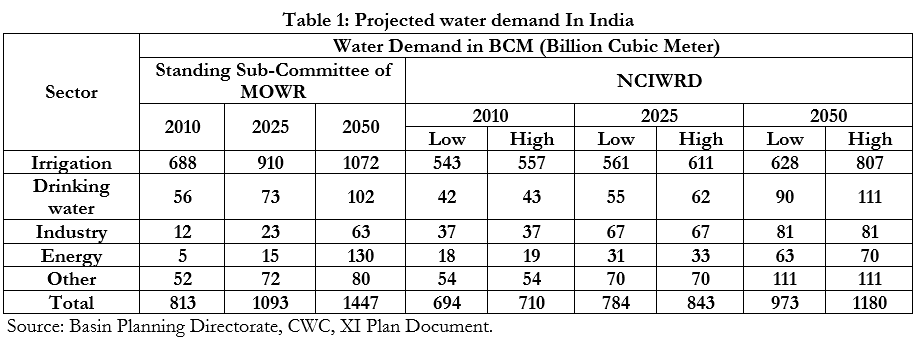
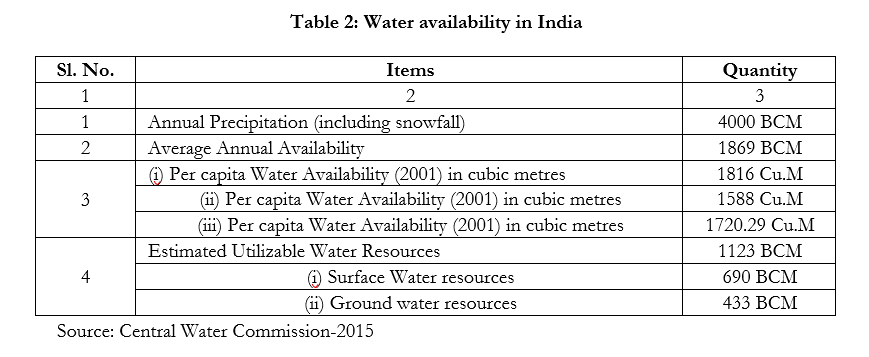
Integration of local communities in water management dialogues
Given the above-mentioned imbalance between water supply and demand, management of water resources such that it caters to the present and future generations become important. In that aspect, the Government of India has acknowledged the need for water management in a scientific way.
Missions like Jal Shakti Abhiyaan across 256 districts and 1592 water stressed blocks in India campaigned for water conservation interventions – such as rainwater harvesting, renovation of traditional and other water bodies/tanks, reuse, bore well recharge structures, watershed development and intensive afforestation.
The success of these efforts lie in their relevance and uptake at the local and individual levels of communities. Also, the sustainability of these effects not only rests with their adoption among the end users but in their conviction about the looming water scarcity and the need to uptake water management practices. In this context, it has become even more important to integrate local communities in dialogues pertaining to water scarcity.
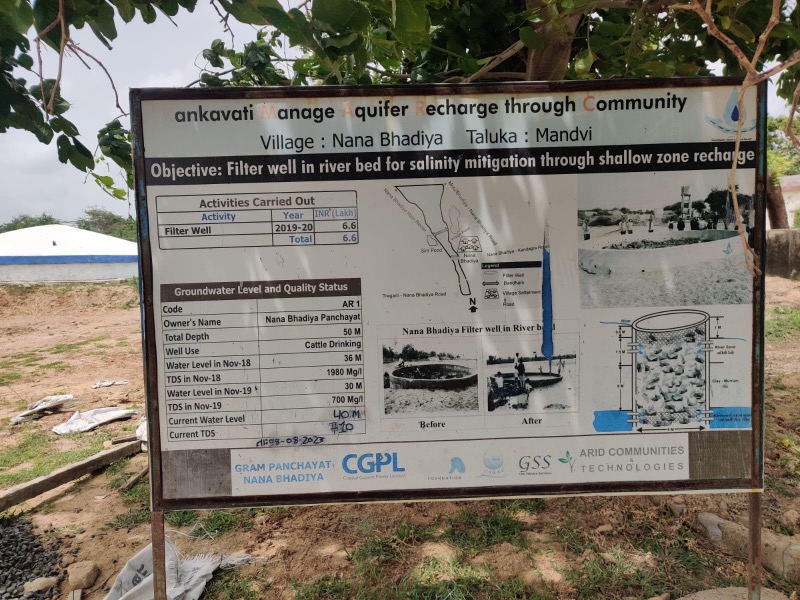
With the diverse geographical spread of India, ideally water management must be case specific. One umbrella-solution might not fit the requirements of the heterogeneous terrains. Therefore, the importance of focusing into the specific water needs and available resources of a community cannot be ignored. Bottom-up approach through participatory planning needs collaborations with the communities living in these areas. This will in turn instil a sense of ownership among them and will make them accountable for the use and management of these practices.
Ensuring accountability such that users understand the importance of these conservation efforts needs behavioural changes. This is the most fundamental requirement that is likely to hold together all the planning and policy decisions. Mindfulness in groundwater extraction as per the needs, adhering to policy guidelines, ensuring timely maintenance of the conservation structures will ensure sustainability of these initiatives. Therefore, capacity building and spreading of awareness are fundamental to bring about behavioural changes.
Sustainable solutions to water management
Different innovation practices and technologies aiming for sustainable water management solutions have gained prominence as a response to the water scarcity. For instance, technologies like faucet, aerators, flush diverters have been introduced to address the water usage patterns in domestic and industrial purposes. Micro irrigation, crop rotations, plantation of seasonal crops, and bio manures help in the preservation of the soil moisture which ultimately leads to curbs in the water demand.
On the other hand, hard constructions, extinction of water bodies, soil erosions have made it difficult for the infiltration of rainwater into the aquifers. Especially in cases of low rainfall areas, arid and semi-arid climatic conditions, the groundwater is even more depleted. Sustainable solutions like rainwater harvesting in these cases can be helpful in addressing the supply side challenges – they help in diverting the runoff of water towards the aquifer.
Some such supply side interventions can be seen through the flagship programs of the State governments like Sujalam Sufalam Yojana in Gujarat, Jalyukt Shivar Abhiyan in Maharashtra, and Pani Bachao Pani Kamao in Punjab among others. Similarly, NGOs, academic research institutions and some foreign institutions are pulling together resources and like-minded people to drive participatory irrigation management programmes and decentralized water management initiatives. To give some examples, from the Kutch area in Gujarat, one can follow the works being undertaken by the NGOs like ACT, WOTR, SRIJAN, SANKALPA with support from funding agencies such as WIN, Aziz Premji Foundation and Arghyam.
The farmers of Kutch region are affected by low rainfall and salinity of water due to coastal and low-lying areas. Both factors affect the quality of water due to high salt concentration which makes it difficult for both agricultural use and impacts livelihood. To address this challenge, farmers have created a recharge pit – which is used to recharge the dry borewell. Areas near the dry borewell has been evaluated to divert the flow of rainwater towards it. A pit is constructed and filled with rocks and sand which also helps in the purification of water. This pit is connected to a borewell through a PVC pipe. A recharge well serving the same purpose is also dug into these areas to the depth of the aquifer.
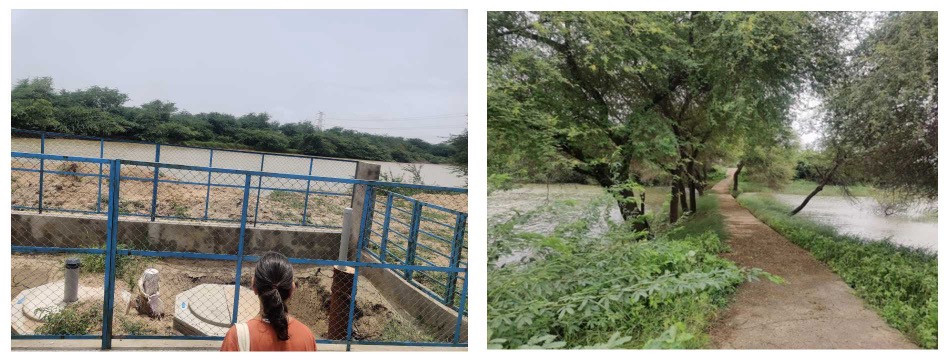
These interventions not only increase the water level but also improve the quality of the water by decreasing the TDS level. Most importantly, rainwater collected in these pits and wells gets stored in the aquifer which in overall keeps recharging the aquifer below. So not just the individual farmer, but farmers within the perimeter of 500 metres gets benefited from such interventions due to increase in water availability in the aquifers. The future of these interventions lies in sustainability where both private needs of the farmers and the societal needs are met.
As one farmer from Khambhaliya, Kutch says that:
“We are benefited by these interventions . Farmers were not interested in agriculture due to drought and quality of water and were looking for labor work. But now with increased water availability, I earn more from my field. The produce has increased. Can you see this bright green color of leaves, it was yellow 15 years ago. This is possible due to artificial recharge well”.
As the looming challenge of water scarcity is already upon us, a holistic sustainable and innovative approach to water management cannot leave behind the involvement of the local communities.
______
Deepak Singhania and Shradhda Jain are associated with IIT Gandhinagar, while Soumi Roy Chowdhury is associated with Janaagraha Centre for Citizenship and Democracy. Views expressed are the author’s own
https://www.linkedin.com/in/deepak-singhania-a055a512/?originalSubdomain=in
https://www.linkedin.com/in/shradhda-jain-433b86129/?originalSubdomain=in
https://www.linkedin.com/in/soumi-roy-chowdhury-869275b3/?originalSubdomain=in
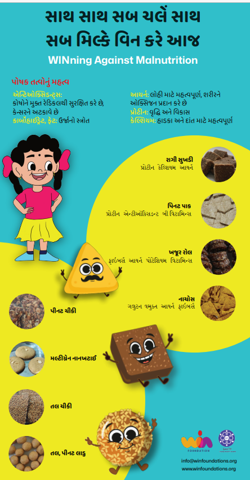 Branding and Brand communication is a course taught at the Institute of Design, Nirma University in Semester VI of Communication Design. The course explores Brand Building and teaches communication theories for strategic communication in the form of campaigns, case studies and advertisements.
Branding and Brand communication is a course taught at the Institute of Design, Nirma University in Semester VI of Communication Design. The course explores Brand Building and teaches communication theories for strategic communication in the form of campaigns, case studies and advertisements.
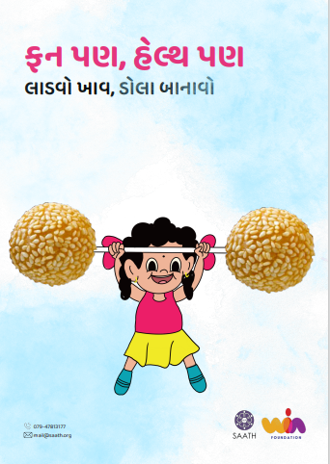 The final collaterals designed were packaging label designs, standees, Tesu female and male mascots, social media posts, an animated video in Gujarati and Hindi and a radio jingle. All of this was done over a span of 3 weeks. At the end of the project our learning and understanding of various aspects of branding, strategies and brand campaigns were clear and we also understood the value of teamwork and co-design to enhance a ‘real-life’ brief.
The final collaterals designed were packaging label designs, standees, Tesu female and male mascots, social media posts, an animated video in Gujarati and Hindi and a radio jingle. All of this was done over a span of 3 weeks. At the end of the project our learning and understanding of various aspects of branding, strategies and brand campaigns were clear and we also understood the value of teamwork and co-design to enhance a ‘real-life’ brief.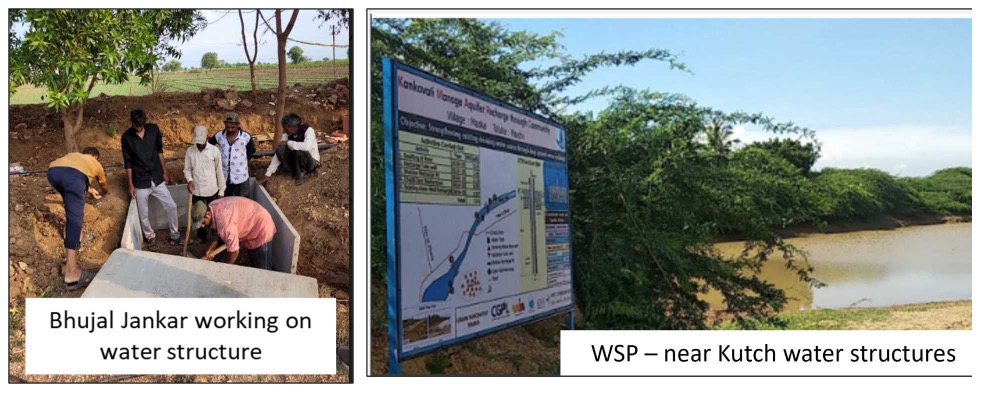
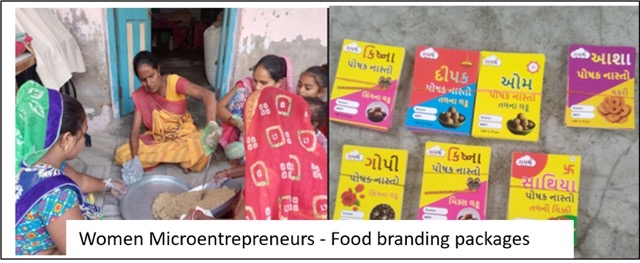
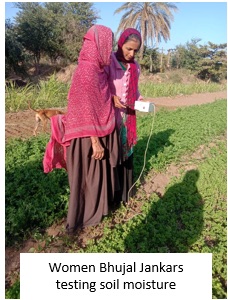 Products and services: Even the rural population is exposed to modern products, and aspires to benefit from such products. Microentrepreneurs have to be trained to scan and adopt new technologies and products from time to time. Fortunately, a lot of affordable technologies are being developed by startups and companies, available for use by local microentrepreneurs to offer better services. E.g. Field usable Soil moisture, soil testing, water testing equipment at low cost, allow the local micro-entrepreneurs to offer services to support smart farming even to marginal farmers. WIN Foundations, through multi-stakeholder collaboration, involving NGOs, startups, institutions, etc. has helped bring affordable state of the art products, bringing products from over 10 startups to the communities.
Products and services: Even the rural population is exposed to modern products, and aspires to benefit from such products. Microentrepreneurs have to be trained to scan and adopt new technologies and products from time to time. Fortunately, a lot of affordable technologies are being developed by startups and companies, available for use by local microentrepreneurs to offer better services. E.g. Field usable Soil moisture, soil testing, water testing equipment at low cost, allow the local micro-entrepreneurs to offer services to support smart farming even to marginal farmers. WIN Foundations, through multi-stakeholder collaboration, involving NGOs, startups, institutions, etc. has helped bring affordable state of the art products, bringing products from over 10 startups to the communities.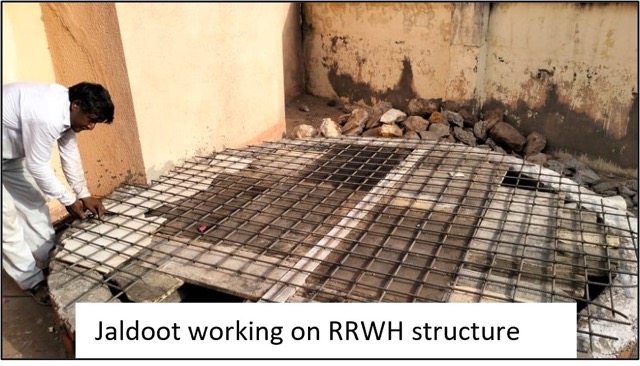
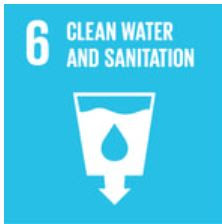 Lack of proper public sanitation infrastructure leads to:
Lack of proper public sanitation infrastructure leads to: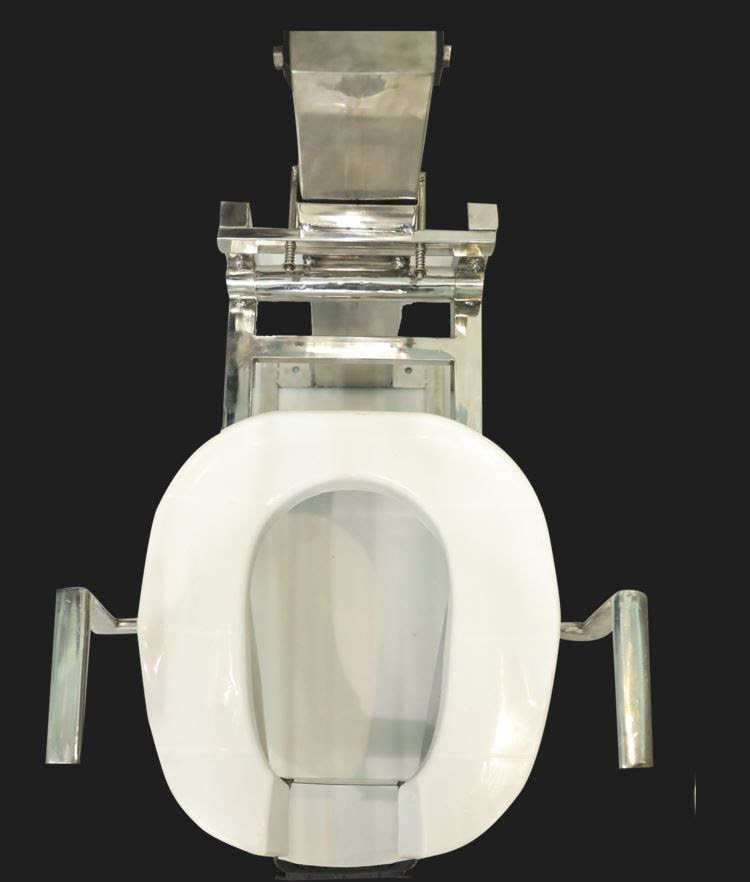 i) Disabled friendly toilet attachment improves access to toilets for the vast population with physical disabilities, thus increasing their usage. WIN Foundation supported Oston Technology in initial stage trials in field. Now these products are being adopted in greater numbers.
i) Disabled friendly toilet attachment improves access to toilets for the vast population with physical disabilities, thus increasing their usage. WIN Foundation supported Oston Technology in initial stage trials in field. Now these products are being adopted in greater numbers.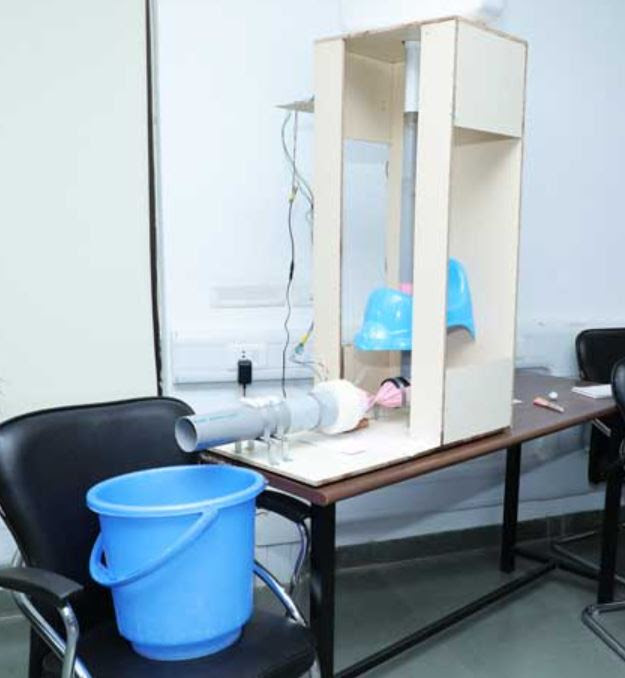 ii) Water saving in flush toilets using hyperboloid technology developed by students from PSG College of Technology, Coimbatore, was the 1st prize award winner in the national Vishwakarma Innovation competition, jointly organized by Maker Bhavan Foundation and WIN Foundation. Toilet flushing requires a lot of water and this innovation can cut it down by about 70%.
ii) Water saving in flush toilets using hyperboloid technology developed by students from PSG College of Technology, Coimbatore, was the 1st prize award winner in the national Vishwakarma Innovation competition, jointly organized by Maker Bhavan Foundation and WIN Foundation. Toilet flushing requires a lot of water and this innovation can cut it down by about 70%.